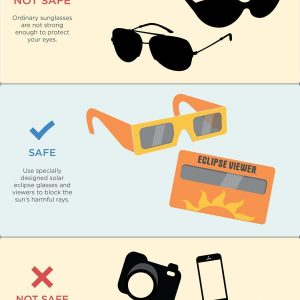How to Safely Watch the Great American Eclipse of 2017
August 13, 2017On Aug. 21, 2017, the entire United States will see a partial eclipse of the sun. Parts of 11 states, including South Carolina, will experience a total solar eclipse. If you get a chance to see it, make sure to take care of your vision during the eclipse.
Watching a solar eclipse is a memorable experience, but looking directly at the sun can seriously damage your eyes. Staring at the sun for even a short time without wearing the right eye protection can damage your retina permanently. It can even cause blindness, called solar retinopathy. The only time it is safe to look directly at the sun is when it is completely covered by the moon during the totality phase of an eclipse.
Areas outside the path of totality will have a partial eclipse. Only part of the sun is blocked even at the peak of the eclipse. In those areas, there is no safe time to look at the sun with the naked eye. You must protect your eyes while watching the entire eclipse.
There is only one safe way to look directly at the sun, whether during an eclipse or not: through special-purpose solar filters. These solar filters are used in “eclipse glasses” or in hand-held solar viewers. They must meet a very specific worldwide standard known as ISO 12312-2.
Keep in mind that ordinary sunglasses, even very dark ones, or homemade filters are not safe for looking at the sun.
Before the eclipse, make sure you are prepared and know how to keep your eyes safe. Based on information provided by the American Astronomical Society, the American Academy of Ophthalmology and the South Carolina Society of Ophthalmology have released these tips for safe eclipse viewing:
- Carefully look at your solar filter or eclipse glasses before using them. If you see any scratches or damage, do not use them.
- Always read and follow all directions that come with the solar filter or eclipse glasses. Help children to be sure they use handheld solar viewers and eclipse glasses correctly.
- Before looking up at the bright sun, stand still and cover your eyes with your eclipse glasses or solar viewer. After glancing at the sun, turn away and remove your filter—do not remove it while looking at the sun.
- The only time that you can look at the sun without a solar viewer is during a total eclipse. When the moon completely covers the sun’s bright face and it suddenly gets dark, you can remove your solar filter to watch this unique experience. Then, as soon as the bright sun begins to reappear very slightly, immediately use your solar viewer again to watch the remaining partial phase of the eclipse.
- Never look at the uneclipsed or partially eclipsed sun through an unfiltered camera, telescope, binoculars or other similar devices. This is important even if you are wearing eclipse glasses or holding a solar viewer at the same time. The intense solar rays coming through these devices will damage the solar filter and your eyes.
- Talk with an expert astronomer if you want to use a special solar filter with a camera, a telescope, binoculars or any other optical device.
For information about where to get the proper eyewear or handheld viewers, check out the American Astronomical Society website.
About the South Carolina Society of Ophthalmology
The South Carolina Society of Ophthalmology is one of the nation’s most recognized and nationally acclaimed State Eye Societies comprised of Eye Physicians and Surgeons specializing in the medical eye practice area of ophthalmology. The South Carolina Society has been recognized repeatedly for its Patient Advocacy programs and its State Physician Leadership, and its Executive Director has received multiple National Awards of Excellence from the American Academy of Ophthalmology.
About the American Academy of Ophthalmology
The American Academy of Ophthalmology is the world’s largest association of eye physicians and surgeons. A global community of 32,000 medical doctors, we protect sight and empower lives by setting the standards for ophthalmic education and advocating for our patients and the public. We innovate to advance our profession and to ensure the delivery of the highest-quality eye care. Our EyeSmart® program provides the public with the most trusted information about eye health. For more information, visit www.aao.org


















